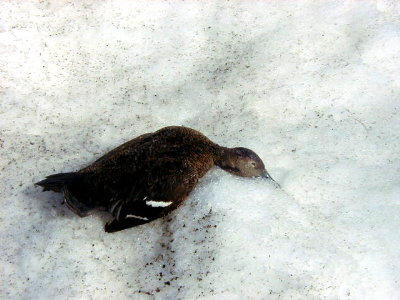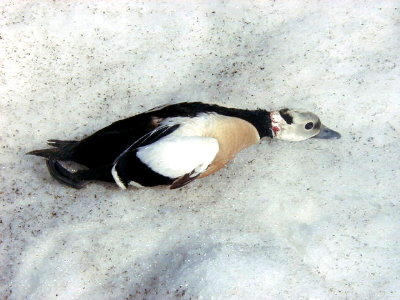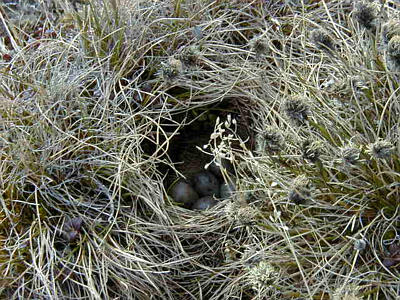
|
|
21 June, 1999
MONDAY, JUNE 21st 1999
CONTENTS: answering questions/the never-ending search for eiders.../arctic
fox/interesting meal plans/GUEST SPEAKER: Bob Ritchie (environmental
consultant)
PICTURES: dead eiders/Phillip Martin on Tundra/Tundra findings/Bob Ritchie
Hi all! I didn't write a journal entry yesterday, because I crashed at
8:30pm! Mostly I have been writing journals from 10pm until 2am, since the
connections take a long time here, and it takes a long time to download the
pictures. It must have all caught up with me yesterday!
First of all, I have some questions to answer:
1. (From Sue) - what is the diets of people like while you are walking on the
tundra? High calorie?
--------Yes! Chocolate is in high demand at the ARF (Arctic Research
Facility). We have chocolate kisses, snickers bars, m and m's , chocolates I
brought from Hawaii, chocolate covered kudos, and little miniture candy bars.
Everyone makes sure to eat breakfast, and pack a decent sized lunch, usually
with peanut butter and whole wheat bread, and then makes sure chocolate is
within easy reach in parka pockets and backpacks for when that quick energy
burst is needed. People come in from the cold and it doesn't take long before
they are scavenging in the cupboards. Other than that, it is pretty much
normal sized meals. I have been thinking I should be losing weight from all
that walking, but the chocolate consumption must be making up for it!
2. (From Ron) How big do Steller's Eiders get, and how many offspring do they
usually have?
-------Both male and female eiders get about 45 cm in length, which is quite
small for a duck. Males weigh a little over 800 grams, and females are closer
to 700 grams. Clutch size, according to Phillip Martin of U.S.F.W. (United
States Fisheries and Wildlife) is usually 5-6 eggs, although sometimes it is 7
eggs. I hadn't put a picture up yet, since I couldn't get a close enough
picture. Unfortunately, we just found a pair that had been shot and left in
the snow, so I finally got a close up. Check it out below!
3. (From Zhu) Have you seen a bowhead whale or a snowy owl?
-------I have not seen a bowhead whale, except chopped up into little peices
at the naluqatak. They migrate past Barrow in the spring, and spend their
summers in the Chuckchi and Beaufort seas, and in the winter, they will
migrate throught the Bering Strait again, to spend their winter in the Bering
Sea. I have seen plenty of Bowhead skulls though, they are everywhere in
Barrow, in town and all along the beach. I have seen lots and lots of snowy
owls, they are nesting on mounds all over the place. They are BIG owls, and
the male is pure white, and the female is white with brown flecks on it. Now
that the snow is melting, they REALLY stand out against the brown tundra. I
haven't gotten a good picture of one, but I have a good picture of their nest!
4. (From Todd) What do you think about while you are out walking on the
tundra all day? It must be boring.
--------Even though the days can get kind of long out there sometimes, it
isn't boring. There are lots of things to look at, like bones of caribou and
even whales (?!)(See pictures below)There are also lemming nests, bird nests,
and little flowering plants. The tundra is getting greener every day. When I
first came, it was really covered with snow yet, but now green shoots are
starting to sprout up. But.... the mind does tend to wander. Grace (from
University of Alaska, Fairbanks) said she is thinking of keeping a notebook
"Deep Thoughts of the Tundra", and I could publish a companion version "Songs
of the Tundra", since strange songs keep popping up in my head. Mostly disco
tunes, for some reason. There also interesting experiences like one of my
survey team members had(I promised not to name names); she decided to use
grass as toliet paper while out in the middle of nowhere, and had the pleasure
of feeling grass in her underwear the rest of the day. Little things like
that just move the day right along...:-D
Today, we once again went out and spent 6 hours or more looking for eiders.
It was very foggy, and the beginning hour of our survey was just trying to
find our way around, since we are now exploring more remote land, away from
the roads. It was beautiful, but Jeb and I (Jeb is from U.S. Fisheries and
Wildlife) did not even see one Steller's Eider. Kara Weller (also from
U.S.F.W.) and I didn't see any today, either! On both days, though, I did get
to see foxes.
Foxes are really neat to see in the wild, because they are as curious
of you as you are of them! Both days I saw them, they saw me and immediately
jogged to a position where they were downwind of me, and then came closer.
They don't want anything to be able to smell them, but if they are downwind
they can get a better smell of you! Arctic fox are white or bluish gray in
the winter, but in the summer thye are gray-brown on their face, tail, back
and legs, and yellowish on their sides and belly. And they are very small!
Most of the foxes in this area I am told carry rabies, so when they are coming
closer for a better look, it made me momentarily worried! But even though
they may carry rabies, the ones that I saw don't show any symptoms of it in
their behavior. They were still very timid. In the winter, they will mostly
eat carrion, which is dead animals. They have an advantage that in the
winter, it is not likely to go rotten up here! They will follow polar bears
for seal meat, or wolves for caribou. During the summer, they will eat lots
of things, like insects, fish, berries, and unfortunately, eggs (even those of
the Steller's Eider)! But they mostly eat lemmings, and when the lemming
population is high, the fox population is high also. When lemming population
crashes, so does the fox population.
There is a theory that the Steller's Eider population is mixed up in
this cycle as well. Maybe when lemming population is high, foxes will eat
lemmings instead of eggs, so the eiders feel safe to nest. There are years
when Steller's Eiders don't nest here at all - they just come and hang out for
a little while, and then leave. Also, maybe more aggressive birds like snowy
owls and pomarine jaegers are more likely to nest when lemming populations are
high, and perhaps when they defend their nest (like the jaegers did against
Grace in June 19th's journal!) they are also protecting the eider's nests,
just by chance. These are all questions that the researchers here are trying
to figure out, but it takes years of collecting data in order to draw any
conclusions.
Anyway, after we got back from trudging on the tundra, we had a
wonderful meal of salmon on the grill, and barbecued Beluga Whale! I only had
a nibble of the beluga, just to say that I tried it. It tasted pretty much
like any kind of barbecued meat - not fishy tasting in the least. I had to
try it, because I know there aren't many chances to eat whales and other
endangered species - only the subsistance hunters are usually exempt from
killing these animals! Many people don't find bowhead whale too tasty unless
you were raised on it. That's lucky, since it would be pretty bad if everyone
who tried it liked it!
I am excited to have Mr. Steve Petty's Earth Science Class from
Wai'anae High School finally connected! I'm really looking forward to your
questions, and hopefully being able to video conference before I leave here!
Take Care, Michele Hauschulz (Teacher Experiencing the Arctic)
GUEST SPEAKER: BOB RITCHIE
Bob Ritchie, Wildlife Biologist
Age: 50 yrs
Education: Bachelors in Wildlife Biology from University of California,
Davis and Masters in Natural Resource Management, University of Alaska,
Fairbanks.
Family: Wife (Bobbie) and three children (ages 17-28)
Hi, Kids. IĎm Bob Ritchie. I own and manage a consulting and research
group called ABR, Inc. Environmental Research and Services. It used to be
called Alaska Biological Research, but since our start in 1976 weíve
expanded our work to include the lower 48 states and studies worldwide. We
now have an office in Portland, Oregon. So what does a consultant do? How
is that different from a scientist working for the U.S. Fish and Wildlife
Service or the Department of Fish and Game? Who pays for our research?
Iíll try to explain by describing a typical summer of work. First, our
clients can be anyone. In Alaska, we work for the oil companies, the Fish
and Wildlife Service, native organizations, and other private and public
groups. Each has a similar need: how many animals are in an area, or how will
our development influence a wildlife species, or do we need to
revegetate an area after an oil spill. We help with understanding the
impacts of these groups and their plans on wildlife, fisheries, habitats,
air, water, etc.
As for me, Iím a wildlife biologist specializing in bird studies. More
specifically, I have worked with raptors (eagles, falcons, and hawks) and
waterfowl (swans, eiders). Currently, Iím helping describe the distribution
and abundance of Stellerís Eiders around Barrow, where your teacher,
Michele, is working. Difference is, that she is putting in long hours
slogging along on the tundra and Iím putting long hours sitting in the back
seat of a plane counting from the air. The pilot flies about 125 feet above
the ground and at speeds about 90 miles per hour. Every time we see an eider
we get a position using a GPS (Global Positioning System) on board, as well as
describing the numbers, habitat and behavior. In the end, weíll have a good
idea of where they congregate.
Seems as if Iíve been flying surveys for wildlife for the past 20 years. It
requires a solid stomach, good eyes, and a good sense of humor. That way you
can entertain the pilot in between surveys! This summer I also will be trying
to count Peregrine falcons from a helicopter, survey for breeding swans from
an airplane, and Ďherdingí brant with a helicopter. For peregrines, I am
trying to determine if they produce young as well in areas without military
jet overflights as they do in areas with overflights. In the last case, weíll
wait until brant, a sea goose, are flightless (early August) and round them up
with a helicopter. We move them into a net pen and capture each one for
banding. Each is marked with a unique numbered and color coded band on their
leg, so that when they migrate along the Pacific Coast to Mexico, biologists
can note where and when they have passed.
But Environmental research isnít just about birds in my office. I have 25
scientists working with me and they have been involved in cleaning up oil
spills, replanting vegetation on areas that have been mined, mapping
endangered plants and animals, and monitoring fisheries populations. I hope
that Iíve given you a good idea of what consultants do! Good luck.
____________________________________________________________________
Get your own FREE, personal Netscape WebMail account today at http://webmail.netscape.com.

Female Steller's Eider. ____________________________________________________________________ Get your own FREE, personal Netscape WebMail account today at http://webm= ail.netscape.com.

Male Steller's Eider. ____________________________________________________________________ Get your own FREE, personal Netscape WebMail account today at http://webm= ail.netscape.com.

Whale vertebrae, found on the tundra. ____________________________________________________________________ Get your own FREE, personal Netscape WebMail account today at http://webm= ail.netscape.com.

Action shot: Bob Ritchie making a sandwich at ARF (Arctic Research Facil= ity) before taking off to do aerial surveys for Steller's Eiders. ____________________________________________________________________ Get your own FREE, personal Netscape WebMail account today at http://webm= ail.netscape.com.

One of the many shorebird nests found on the tundra. We have to be caref= ul where we step! ____________________________________________________________________ Get your own FREE, personal Netscape WebMail account today at http://webm= ail.netscape.com.

Phillip Martin (from U.S.F.W.S.) trekking across snowy tundra ____________________________________________________________________ Get your own FREE, personal Netscape WebMail account today at http://webm= ail.netscape.com.

Me, inside a bowhead whale's skull! ____________________________________________________________________ Get your own FREE, personal Netscape WebMail account today at http://webm= ail.netscape.com.
Contact the TEA in the field at
.
If you cannot connect through your browser, copy the
TEA's e-mail address in the "To:" line of
your favorite e-mail package.
|
